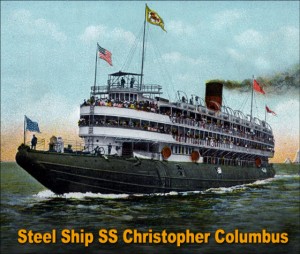An Innovative Marvel in American Maritime History
In 1893, the gates opened on the World Columbian Exposition in Chicago, unveiling numerous iron and steel built wonders, including a steel-hulled excursion liner christened the SS Christopher Columbus.
Planning for the World Columbian Exposition, also known as the Chicago World’s Fair, began in the late 1880s. New York, Chicago, St. Louis, and Washington D.C. all vied for the privilege of hosting the Exposition. The United States Congress awarded Chicago with the project in 1890.
 The Exposition Committee set up offices in Chicago’s Rand McNally Building, the world’s first steel framed skyscraper.
The Exposition Committee set up offices in Chicago’s Rand McNally Building, the world’s first steel framed skyscraper.
Designed as a celebration of the 400th anniversary of Christopher Columbus’s discovery of America, the World Columbian Fair should have opened in 1892. However, the inevitable construction delays involved in a project of such massive proportions pushed the opening to May 1, 1893.
The Steel Built SS Christopher Columbus
Ship designer Captain Andrew McDougall saw the Exposition as the perfect opportunity to increase interest in his new “whaleback” iron ships.
Although initially designed to carry greater cargo loads across the Great Lakes, McDougall believed whaleback vessels would also serve well as passenger ships. He proposed building one to ferry guests to the Chicago World’s Fair.
McDougall’s American Steel Barge Company constructed the SS Christopher Columbus in 1892 and early 1893. The ship was christened on May 13, 1893.
At 362’feet in length, the SS Christopher Columbus was the longest whaleback ship ever constructed. It was also the only whaleback passenger liner ever built.
The vessel weighed 1,511 gross register tons. Six massive boilers powered her triple expansion steam engines, driving 18-foot propeller. The Columbus traveled at speeds up to 20 m.p.h.
Four thousand passengers traveled in luxurious comfort on each round-trip excursion of the Columbus. A crew of 170 cared for the travelers and ship operations.
The elegant appointments of the SS Christopher Columbus included electric lighting, etched glass windows, leather-covered furniture, marble-decked counters, and skylights. The promenade decks featured several lovely fountains— and even aquariums filled with Great Lake fish.
An orchestra supplied on-board music as 500 couples swayed across the vast dance floor. Shops and restaurants catered to pleasure seekers aboard. Well-appointed club rooms provided space for business meetings.
After the Fair Was Over
After the Fair, the Columbus started making pleasure trips from Chicago, IL to Milwaukee, WI. Advertisements promised “170 miles o’ smiles” for $1.50 per round trip ticket on the “big steel ship Christopher Columbus.”
One of the first ships to boast an on-board radio, the Columbus was able to summon help for the 200 passengers of the disabled City of Racine liner on Lake Michigan in 1909.
During her 40-year career, the Columbus carried more passengers than any other vessel on the Great Lakes.
Steel Built Structures Continue Today
RHINO Steel Building Systems continues the tradition of innovations in steel with pre-engineered steel building systems. Strong, dependable, long-lasting, and economical, RHINO metal buildings create structures for every commercial and industrial need.
Barns, retail outlets, big-box stores, restaurants, aircraft hangars, offices, manufacturing plants, vehicle dealerships, warehouses— whatever the need, steel built structures offer the best choice.
Need more information? Speak to a friendly and knowledgeable RHINO metal building consultant today about any low-rise building project. Call us at 940.383.9566.
